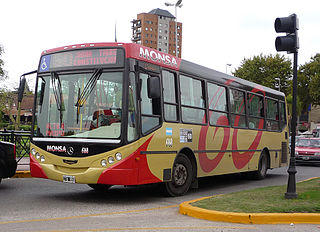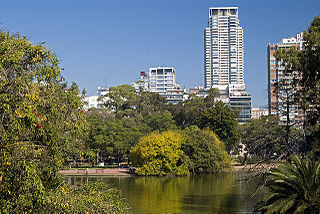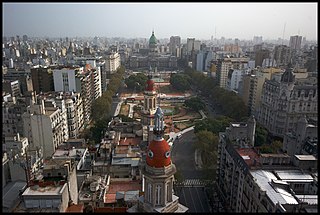
The Casa Rosada is the executive mansion and office of the President of Argentina. The palatial mansion is known officially as Casa de Gobierno. Normally, the President lives at the Quinta de Olivos, the official residence of the President of Argentina, which is located in Olivos, Greater Buenos Aires. The characteristic color of the Casa Rosada is baby pink, and is considered one of the most emblematic buildings in Buenos Aires. The building also houses a museum, which contains objects relating to former presidents of Argentina. It has been declared a National Historic Monument of Argentina.

Belgrano is a northern and leafy barrio or neighborhood of Buenos Aires, Argentina.

Palermo is a barrio or neighborhood of Buenos Aires, Argentina. It is located in the north of the city, near the Rio de la Plata.

Carlos Thays was a French-Argentine landscape architect, and a student of French landscape architect Édouard André.

The Colectivo 60 was founded in 1931 and runs from Constitución station, in the centre of the city of Buenos Aires, Argentina to the Tigre Club in the partido of Tigre. The service is operated by Nudo S.A., Azul S.A.T.A. and M.O.T.S.A. and the identifying color of the buses is yellow, with red and black details.

Parque Tres de Febrero, popularly known as Bosques de Palermo, is an urban park of approximately 400 hectares located in the neighborhood of Palermo in Buenos Aires, Argentina. Located between Libertador and Figueroa Alcorta Avenues, it is known for its groves, lakes, and rose gardens.

The Buenos Aires Botanical Garden is a botanical garden located in the Palermo neighborhood of Buenos Aires in Argentina. The garden is triangular in shape, and is bounded by Santa Fe Avenue, Las Heras Avenue and República Árabe Siria Street.

The Buenos Aires Zoo was an 45-acre (18 ha) zoo in the Palermo district of Buenos Aires, Argentina. The zoo contained 89 species of mammals, 49 species of reptiles and 175 species of birds, with a total of over 2,500 animals. The institution's goals are to conserve species, produce research and to educate the public. In June 2016 the city formed a bias about the zoo's cruelty. They had to close the 140-year-old zoo and relocate most of the animals to nature reserves, including Temaikèn. The zoo property will be converted into an ecopark.

Buenos Aires is in the midst of a tourism boom, according to the World Travel & Tourism Council, which reveals strong growth for Argentina Travel and Tourism in 2007 and in coming years, and the prestigious travel and tourism publication; Travel + Leisure, a monthly magazine, travelers voted Buenos Aires the second most desirable city to visit after Florence, Italy. Buenos Aires, regarded as the “Paris of South America”, offers elegant architecture, exquisite cuisine, a legendary nightlife, and fashionable shopping. Argentina has become famous for its rich European flavor.

The Monumento a Giuseppe Garibaldi is an equestrian sculpture featuring Giuseppe Garibaldi, located on Plaza Italia, a landmark in the Palermo neighbourhood of Buenos Aires, Argentina.

Villa Luro is a barrio (district) of Buenos Aires, Argentina. It is located near the western end of the City of Buenos Aires.

Avenida Rivadavia is one of the principal thoroughfares in Buenos Aires, Argentina, extending 23 miles (37 km) from downtown Buenos Aires to the western suburb of Merlo.

Avenida Santa Fe is one of the principal thoroughfares in Buenos Aires, Argentina. The artery is essential to the imaginary axis of Barrio Norte in Buenos Aires, comprising the areas influenced by the route of the avenue through Retiro, Recoleta and Palermo neighborhoods, it is considered one of the main shopping and strolling areas of the city, its many boutiques range from elegant to edgy, which has led it to be dubbed the 'Avenue of Fashion'. Upscale Alto Palermo, at Avenida Coronel Díaz, is one of the city's best-known vertical malls. Avenida Santa Fe is also an attraction for its architecture, strongly reminiscent of Paris. Its name pays homage to the eponymous province in Argentina.

Avenida Figueroa Alcorta is a major thoroughfare in Buenos Aires, Argentina, with a length of over 7 km (4.3 mi) along the city's northside.

Congressional Plaza is a public park facing the Argentine Congress in Buenos Aires. The plaza is part of a 3 hectare open space comprising three adjoining plazas to the east of the Congress building. The Kilometre Zero for all Argentine National Highways is marked on a milestone at the Plaza.

Callao Avenue is one of the principal thoroughfares in Buenos Aires, Argentina.

Plaza Italia station is part of the line D of the Buenos Aires Underground. It is located at the intersection of Avenida Santa Fe and the roundabout surrounding Plaza Italia in Palermo. The station was opened on 23 February 1940 as part of the extension of Line D from Tribunales to Palermo.

Avenida General Sarmiento is an avenue located in the Palermo neighborhood, in Buenos Aires, Argentina. It runs from Plaza Italia to the Costanera Rafael Obligado Avenue, across the Parque Tres de Febrero.




















